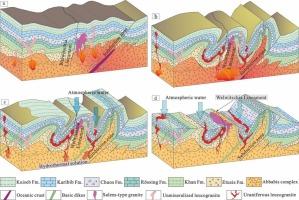纳米比亚中部达马拉带Gaudeanmus地区白花岗岩型铀矿床成因:矿物学特征及铀矿U-Pb原位同位素特征
IF 3.6
2区 地球科学
Q1 GEOLOGY
引用次数: 0
摘要
纳米比亚铀矿资源丰富,类型多样,其中白花岗岩型铀矿是最重要的铀矿之一。根据岩石矿物学鉴定和EPMA分析,Gaudeanmus矿床位于Rössing矿床东南部,是一个典型的白花岗岩型铀矿床,铀主要以独立铀矿物形式存在,或稀含于其他矿物中,呈同构状。然而,浅花岗岩结晶与铀矿化的成因关系,以及岩浆作用与后期热液作用的确切作用,仍是尚未解决的科学问题。本研究旨在解决这些问题。铀矿物主要为铀矿,少量有钍矿、铀矿、银矿、硼铁矿、铀矿、沥青铀矿、铀矿。Gaudeanmus铀矿床主要受构造、浅花岗岩和地层的控制,铀矿床主要受构造、浅花岗岩和地层的控制。构造变形创造了穹窿、褶皱和裂缝,为成矿提供了空间和流体通道。D型和e型亮花岗岩通过部分熔融结晶供给铀,Karibib组和Kuiseb组是有利的容矿层。晚期热液溶液促进了铀的局部富集。矿体主要赋存于褶皱弯曲、穹隆边缘及断层转换(如过渡、膨胀等)之间,有充足的铀矿化空间。Welwitschia区域断裂为铀的活化和运移提供了通道。矿化浅色花岗岩具有只有D型和E型浅色花岗岩含铀而其他类型的浅色花岗岩和salem型花岗岩不含铀的特殊性质,矿化浅色花岗岩通常侵入Gaudeanmus地区的Karibib和Kuiseb组。后期流体有利于铀矿化的叠加富集。锆石和铀矿的LA-ICP-MS原位U-Pb测年结果表明,成岩年龄为499±30 Ma,铀的主成矿年龄为502±3 Ma,表明铀的主成矿年龄与浅花岗岩的成岩年龄基本一致。浅花岗岩型铀矿床主成矿阶段的铀来自富铀的达马拉前基底,热液叠加转化阶段的铀可能来自原生铀矿物本身。浅花岗岩型铀矿床的成矿作用大致可分为三个阶段:原生岩浆结晶分异期、晚期热液叠加转化期和后成氧化期。在此基础上,建立了四阶段三期铀矿化模型。与以往研究仅从概念上概述模型不同,本研究结合了新的矿物学证据和铀矿石和锆石的原位U-Pb年龄,表明岩浆作用和成矿作用是同时期的,从而完善了成因模型。本文章由计算机程序翻译,如有差异,请以英文原文为准。

Genesis of the leucogranite-hosted uranium deposit in Gaudeanmus area, Central Damara Belt, Namibia, constrained by mineralogical, and in-situ U-Pb isotopic signatures of uraninite
In Namibia, there are abundant uranium resources of different types, and therein, leucogranite-hosted uranium deposit is one of the most important. The Gaudeanmus deposit, located in southeast of the Rössing deposit, is a typical leucogranite-hosted uranium deposit where uranium dominantly exists in independent uranium minerals, or is sparsely contained in other minerals as isomorphism, according to petrologic and mineralogic identification and EPMA analysis. However, the genetic relationship between leucogranite crystallization and uranium mineralization, and the precise role of magmatism versus later hydrothermal processes, remain unresolved scientific issues. This study aims to address these questions. The uranium minerals are mainly uraninite as well as a few thoriumurite, coffinite, brannerite, betafite, uranothorite, pitchblende and uranophane. The Gaudeanmus uranium deposit is mainly controlled by tectonics, leucogranite and strata, the uranium deposits are mainly controlled by tectonics, leucogranite and strata. Tectonic deformation created domes, folds and fractures that provided space and fluid pathways for mineralization. D- and E-type leucogranites supplied uranium through partial melting and crystallization, while the Karibib and Kuiseb Formations acted as favorable host strata for ore accumulation. and late hydrothermal solution has promoted locally the enrichment of uranium. The ore bodies mainly occur at bend of folds, on edge of domes and in between fault transformations (such as transitions, expansions, etc.), where there is a sufficient space for uranium mineralization. The Welwitschia regional fault provided a channel for activation and migration of uranium. The mineralized leucogranite contains specific property that only D and E types of leucogranite contains uranium, but other types of leucogranite and Salem-type granite mineralization does not, and the mineralized leucogranite usually intruded into the Karibib and Kuiseb formations in Gaudeanmus area. The anaphasis fluid was helpful for superposition enrichment for uranium mineralization. LA-ICP-MS in-situ U-Pb dating of zircon and uraninite shows that the diageneic age is 499 ± 30 Ma and the main mineralization age of uranium is 502 ± 3 Ma, which indicated that the main mineralization age of uranium is basically consistent with the diagenic age of leucogranite. The uranium at the main metallogenic stage of the leucogranite-hosted uranium deposit came from the uranium-rich pre-Damara basement, and the uranium at the hydrothermal superposition transformation stage might come from the primary uranium mineral itself. The mineralization of leucogranite-hosted uranium deposits can be roughly divided into three periods: crystalline differentiation of primary magma, superimposed transformation of late hydrothermal fluid and epigenetic oxidation. Based on this, a four-stage, three-period uranium mineralization model has been established. Unlike previous studies that only outlined the model conceptually, this study integrates new mineralogical evidence and in-situ U-Pb ages of uraninite and zircon, demonstrating that magmatism and mineralization were contemporaneous, thus refining the genetic model.
求助全文
通过发布文献求助,成功后即可免费获取论文全文。
去求助
来源期刊

Ore Geology Reviews
地学-地质学
CiteScore
6.50
自引率
27.30%
发文量
546
审稿时长
22.9 weeks
期刊介绍:
Ore Geology Reviews aims to familiarize all earth scientists with recent advances in a number of interconnected disciplines related to the study of, and search for, ore deposits. The reviews range from brief to longer contributions, but the journal preferentially publishes manuscripts that fill the niche between the commonly shorter journal articles and the comprehensive book coverages, and thus has a special appeal to many authors and readers.
 求助内容:
求助内容: 应助结果提醒方式:
应助结果提醒方式:


